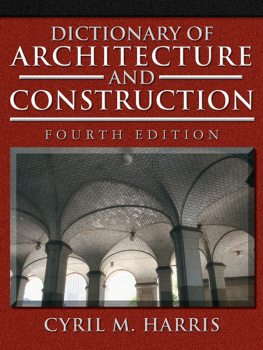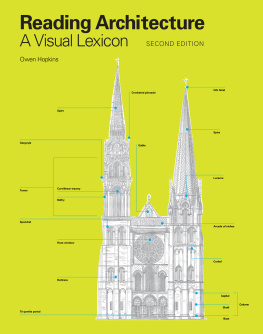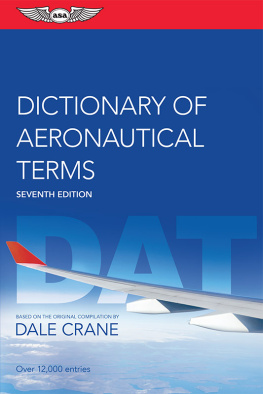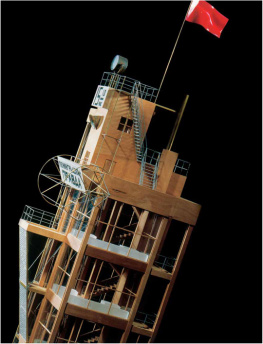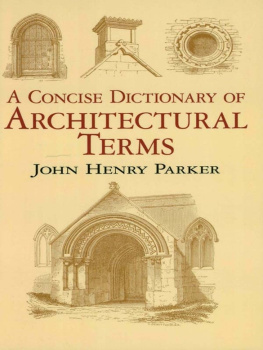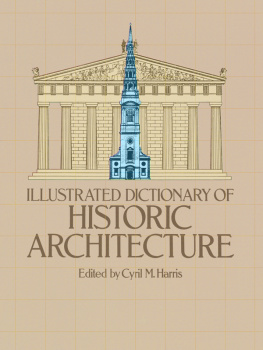DICTIONARY OF ARCHITECTURE & CONSTRUCTION
DICTIONARY OF ARCHITECTURE & CONSTRUCTION
2300 illustrations
Fourth Edition
Edited by
Cyril M. Harris
Professor Emeritus of Architecture
Graduate School of Architecture, Planning, and Preservation
Columbia University
McGraw-Hill
New York Chicago San Francisco Lisbon London
Madrid Mexico City Milan New Delhi San Juan
Seoul Singapore Sydney Toronto
Library of Congress Cataloging-in-Publication Data
Dictionary of architecture & construction / edited by Cyril M. Harris.4th ed.
p. cm.
1. ArchitectureDictionaries. 2. BuildingDictionaries. I. Title: Dictionary of architecture and construction. II. Harris, Cyril M., date.
NA31.H32 2005
720.3dc22
2005042340
Copyright 2006, 2000, 1993, 1975 by The McGraw-Hill Companies, Inc. All rights reserved. Except as permitted under the United States Copyright Act of 1976, no part of this publication may be reproduced or distributed in any form or by any means, or stored in a database or retrieval system, without the prior written permission of the publisher.
ISBN :978-0-071-58901-7
MHID :0-07-158901-5
The material in this eBook also appears in the print version of this title: ISBN 978-0-071-45237-3, MHID 0-07-145237-0.
All trademarks are trademarks of their respective owners. Rather than put a trademark symbol after every occurrence of a trademarked name, we use names in an editorial fashion only, and to the benefit of the trademark owner, with no intention of infringement of the trademark. Where such designations appear in this book, they have been printed with initial caps.
McGraw-Hill eBooks are available at special quantity discounts to use as premiums and sales promotions, or for use in corporate training programs. To contact a representative please e-mail us at .
The sponsoring editor for this book was Cary Sullivan and the production supervisor was Richard Ruzycka. It was set in Goudy by International Typesetting and Composition. The art director for the cover was Anthony Landi.
TERMS OF USE
This is a copyrighted work and The McGraw-Hill Companies, Inc. (McGraw-Hill) and its licensors reserve all rights in and to the work. Use of this work is subject to these terms. Except as permitted under the Copyright Act of 1976 and the right to store and retrieve one copy of the work, you may not decompile, disassemble, reverse engineer, reproduce, modify, create derivative works based upon, transmit, distribute, disseminate, sell, publish or sublicense the work or any part of it without McGraw-Hills prior consent. You may use the work for your own noncommercial and personal use; any other use of the work is strictly prohibited. Your right to use the work may be terminated if you fail to comply with these terms.
THE WORK IS PROVIDED AS IS. McGRAW-HILL AND ITS LICENSORS MAKE NO GUARANTEES OR WARRANTIES AS TO THE ACCURACY, ADEQUACY OR COMPLETENESS OF OR RESULTS TO BE OBTAINED FROM USING THE WORK, INCLUDING ANY INFORMATION THAT CAN BE ACCESSED THROUGH THE WORK VIA HYPERLINK OR OTHERWISE, AND EXPRESSLY DISCLAIM ANY WARRANTY, EXPRESS OR IMPLIED, INCLUDING BUT NOT LIMITED TO IMPLIED WARRANTIES OF MERCHANTABILITY OR FITNESS FOR A PARTICULAR PURPOSE. McGraw-Hill and its licensors do not warrant or guarantee that the functions contained in the work will meet your requirements or that its operation will be uninterrupted or error free. Neither McGraw-Hill nor its licensors shall be liable to you or anyone else for any inaccuracy, error or omission, regardless of cause, in the work or for any damages resulting therefrom. McGraw-Hill has no responsibility for the content of any information accessed through the work. Under no circumstances shall McGraw-Hill and/or its licensors be liable for any indirect, incidental, special, punitive, consequential or similar damages that result from the use of or inability to use the work, even if any of them has been advised of the possibility of such damages. This limitation of liability shall apply to any claim or cause whatsoever whether such claim or cause arises in contract, tort or otherwise.
This book is dedicated to the memory of Adolph K. Placzek, Avery Librarian at Columbia University, whose leadership made Avery Library one of the worlds greatest collections on architecture. I am grateful to him for long and fruitful discussions, for his exemplary scholarship, and for the generosity of spirit with which he shared his experience, his wisdom, and the gift of his friendship.
PREFACE
This Fourth Edition of the Dictionary of Architecture & Construction defines more terms in architecture and building construction than any other dictionary in the English language. Because there have been significant changes, advances, and new developments in building materials and services, construction techniques, engineering practices, specifications writing, environmental concerns, community regulations, legal requirements, and other areas over the last decade, a total of 2500 new terms, as well as 100 new illustrations, have been added to this edition. This coverage provides an up-to-date working tool for practicing professionals in the many fields and numerous trades related to architecture and construction, as well as an invaluable resource for conservationists, planners, architectural historians, and students.
The Dictionary is designed to be comprehensive in scope. Its range spans terms encountered in the practice of architecture from Classical to green, from traditional materials to the latest products, from precise definitions of architectural styles to the particulars of specifications writing. Many of the new terms are associated with major expansions in the field of building services, including air-conditioning systems, electrical supply systems, gas supply services, illumination engineering, noise control engineering, vertical transportation systems, security services, and waste disposal, water supply, and fire protection systems. Other definitions pertain to environmental concerns, conservation, building preservation, community regulations, and recent applications of the Americans with Disabilities Act. Equivalent values in Standard International units are given for U.S. Customary units.
Cyril M. Harris
ACKNOWLEDGMENTS
The editor owes a special debt to the core group of 54 contributors who helped establish the high standard of quality of the Dictionary; coming from widely diverse backgrounds, including practicing architects, professional engineers, specification writers, craftsmen, contractors, and art historians, they provided the necessary expertise required for a comprehensive, authoritative work. I thank Walter F. Aikman; William H. Bauer; Bronson Binger, AIA; Donald Edward Brotherson, AIA; Robert Burns, AIA; A. E. Bye, F.A.S.L.A.; Richard K. Cook, Ph.D.; William C. Crager, C.S.P.; Frank L. Ehasz, Ph.D., PE; Francis Ferguson, AIA, AIP; Frederick G. Frost, FAIA; Alfred Greenberg, PE; John Hagman; Michael M. Harris, FAIA; R. Bruce Hoadley, D.For.; Jerome S. B. Iffland, PE; George C. Izenour, AIEEE; Curtis A. Johnson, M.Sc., PE; Edgar Kaufmann, Jr., HAIA; Thomas C. Kavanaugh, Sc.D.; Robert L. Keeler; George Lacancellera, CSI; Paul Lampl, M.A., AIA; Valentine A. Lehr, M.S.C.E., PE; Robert E. Levin, Ph.D., PE; George W. McLellan; Emily Malino, AID; Roy J. Mascolino, R.A.; Donald E. Orner, PE; John Barratt Patton, Ph.D.; Adolf K. Placzek, Ph.D.; Albert J. Rosenthal, L.L.B.; Henry H. Rothman, F.F.C.S.; James V. Ryan, M.S.; John E. Ryan, PE, S.F.P.E.; Reuben Samuels, PE, F.A.S.C.E.; Joseph Shein, AIA; Joseph M. Shelley, B.S.Arch.; Kenneth Alexander Smith, AIA, PE; Perry M. Smith, PE; Fred G. Snook, M.S.; Carl A. Swanson, B.C.E., CSI; Kenneth Thomas, M.Sc., C.Eng.; Charles W. Thurston, Ph.D., PE; Marvin Trachtenberg, Ph.D.; Everard M. Upjohn, M.Arch.; Oliver B. Volk; and Byron G. Wels.

